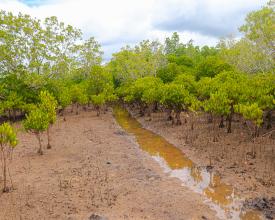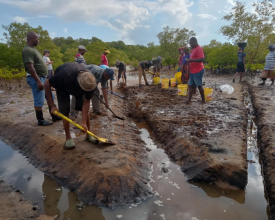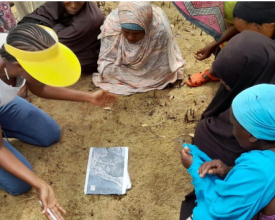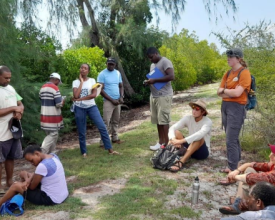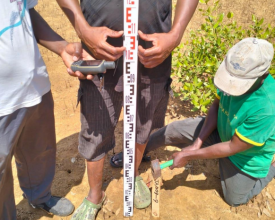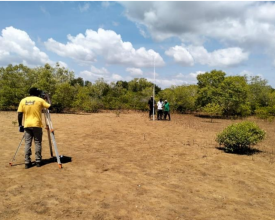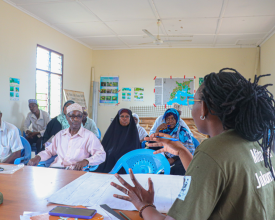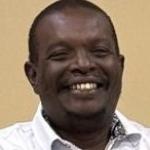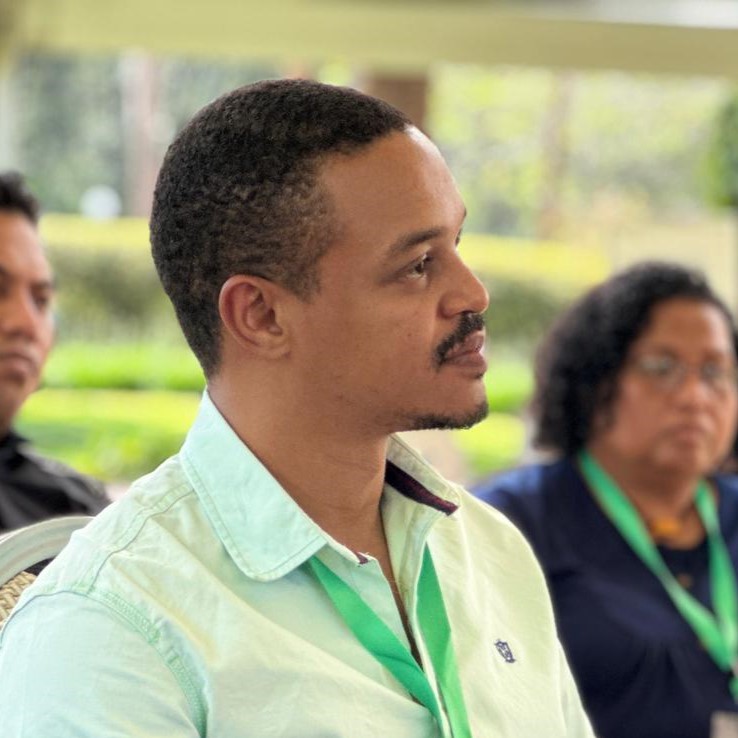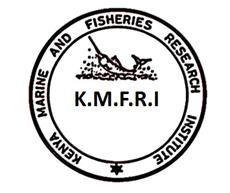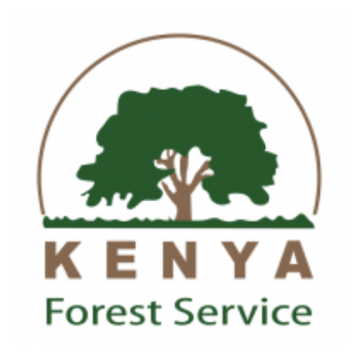
Hydrological restoration of mangroves in saltpans of Jimbo
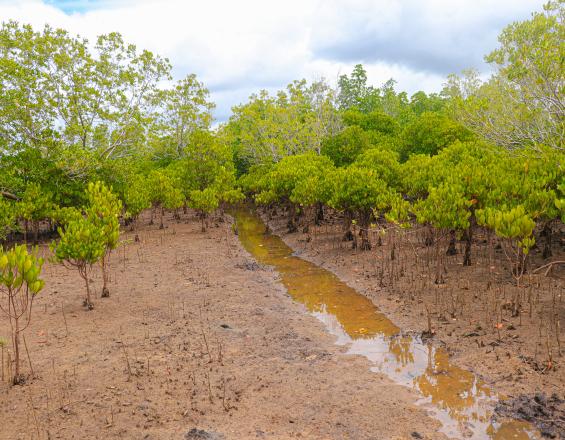
Nestled along the Kenyan coast, the Vanga, Jimbo, and Kiwegu Community Forest Association (VAJIKI CFA) focused on the sustainable mangrove conservation in Vanga Bay, Kwale in response to frequent cholera outbreaks that threatened the local fishing community due to pollution, deforestation and land use changes. 2004 Tsunami spurred them to use traditional knowledge in restoring degraded mangrove areas through planting initiatives. In Jimbo, salt mining in 1990s occupying about 10 hectares led to mangrove degradation, high salinity and stunted growth. VAJIKI CFA thus implemented a hydrological restoration approach after unsuccessful attempts to rehabilitate by planting. This solution involved training the community to restore natural water flow within the salt pans by creating a network of channels. This reduced salinity levels by improving water circulation, encouraging healthier mangrove growth. The successful restoration of channels revitalized the ecosystem and equipped community members with essential restoration skills.
Contexte
Défis à relever
Environmental: The solution has addressed land and forest degradation, biodiversity loss, and salinisation.
Social: The approach has boosted food security by reviving mangroves as breeding grounds for molluscs, which are fish bait that support small-scale fisheries.
Ecological challenges: Ecosystem loss has been addressed by this solution
Emplacement
Traiter
Résumé du processus
The hydrological restoration project's success hinges on interconnected components that complement each other:
- Participatory and inclusive baseline survey provides essential data on hydrological conditions, salinity, and mangrove health, laying the groundwork for effective restoration strategies. This survey, involving the local community, informs subsequent interventions.
- Field-based training on ecological mangrove restoration offers communities practical, site-specific knowledge and skills to implement restoration effectively.
- Collaboration between the mandated government institution, researchers and communities enhances the application of scientifically sound restoration efforts.
- Continuous Community Engagement ensures ongoing support and investment by maintaining regular communication and addressing concerns.
Blocs de construction
Participatory and Inclusive Baseline Survey
The project involved engaging the local community in a baseline survey to assess the hydrological conditions and the appropriate restoration approach. The survey aimed to gather information on water flow, salinity levels and mangrove health, which are necessary for designing effective hydrological restoration strategies.
Facteurs favorables
- We are involving local community members to provide valuable insights into the project.
- The provision of diverse perspectives helps in gathering detailed and accurate information.
Leçon apprise
- Community involvement is crucial for collecting accurate baseline data and understanding specific local conditions.
- Ensuring diverse participation enhances the effectiveness of the restoration design by incorporating various viewpoints and addressing all relevant issues.
Field-Based Training
Field-based training allowed community members to gain practical involvement and experience in the process of hydrological restoration. The community members to be engaged in the activities were identified through the village heads and VAJIKI CFA officials. Meetings were first held with opinion leaders in the village before extrapolating to the larger community. They then went through training, which was mainly field-based. The community was trained on general mangrove restoration and on how to create a (fishbone) network of channels in the degraded site to facilitate free and almost simultaneous flooding of the area. Hydrological restoration was trained in the field, allowing the community to observe and appreciate the baseline conditions and the modifications that could be made.
Facteurs favorables
- Practical demonstrations in the field allow community members to engage directly with the restoration process and understand the techniques used.
- Training focusing on site-specific conditions ensures that the skills learned directly apply to the restoration.
Leçon apprise
- Hands-on, site-specific training is more effective than theoretical lessons alone. Engaging with actual conditions enhances understanding and application of restoration techniques.
- Continuous training and skill development are essential for maintaining progress and ensuring the project's long-term success.
Collaboration with Partners
During the project, the partners involved were different users of the Vanga mangrove, both directly and indirectly, and all depended on the existence of the forest to accomplish their uses. These include fishermen, beekeepers, dagaa processors, Vanga Blue Forest, researchers, Kenya Marine and Fisheries Research Institute, Kenya Forest Service and WWF-Kenya. This was necessary for successful hydrological restoration. This collaboration ensured that resources were shared, efforts were coordinated, and the restoration process benefited from diverse expertise.
Facteurs favorables
- Working with VAJIKI CFA, Kenya Forest Service, Kenya Marine and Fisheries Research Institute, and other stakeholders facilitates resource sharing and coordinated efforts.
- Leveraging the knowledge and experience of various partners enhances the planning and execution of the hydrological restoration activities.
- Citizen science enhances monitoring activities, increases community investment in the restoration project and provides valuable insights into local conditions and changes.
Leçon apprise
- Effective collaboration among partners is vital for the success of hydrological restoration projects. Clear roles and open communication improve project outcomes.
- Sharing resources and expertise among partners enhances the efficiency and impact of restoration efforts.
- Promoting shared ownership among stakeholders leads to more effective and sustainable restoration outcomes.
Research-Led and Ecological Mangrove Restoration
This project was initiated against the backdrop of an existing community forest association (VAJIKI) that had expressed interest in the conservation of mangroves. The community had already been engaging in planting mangroves, but in this specific area, attempts had yet to bear fruit. Although no meaningful salt production took place, salt pans had earlier on been excavated in the area, resulting in the clearing of about 10 ha of mangroves. The site had since remained bare due to the extremely high salinity levels that hindered the recovery of mangroves even upon abandonment of salt production.
Guiding the restoration efforts based on research and ecological principles ensured that the hydrological interventions were scientifically sound and ecologically appropriate. This approach involved applying research findings to address specific challenges related to water flow, salinity, and mangrove health.
Facteurs favorables
- Using research and ecological principles to guide restoration efforts ensures that interventions are based on a scientific approach.
- Applying research findings to the specific conditions of the project area helps in designing effective interventions.
- Engaging community members in the research process ensured that citizen science and needs were reflected in the restoration strategies.
- Involving stakeholders in research fostered a sense of shared responsibility and commitment to the restoration goals.
Leçon apprise
- Incorporating scientific research into the restoration design enhances the effectiveness and sustainability of the interventions.
- Adapting techniques based on ongoing research and field observations is crucial for addressing dynamic hydrological conditions.
- Incorporating local perspectives into the research process enhances the relevance and applicability of the findings.
Continuous Community Engagement Throughout the Project Period
Some community members had heard of success stories from elsewhere but were pessimistic, considering the unpaying efforts they had already put into restoring the area. Sensitization meetings were conducted regarding the hydrological restoration approach to ensure that the community was adequately included. Through VAJIKI CFA, the community was informed of the upcoming hydrological activity. Through the village heads, 30 communities participated in the hydrological restoration and monitoring training.
Regular communication with the local community throughout the hydrological restoration project ensured ongoing involvement and support. This engagement helped keep the community informed, addressed their concerns and fostered a sense of ownership over restoration efforts.
Facteurs favorables
- Providing continuous updates and engaging the community throughout the project ensures sustained involvement and support.
- Establishing channels for community feedback helps address concerns and improve the effectiveness of restoration activities.
Leçon apprise
- Continuous community engagement is essential for maintaining interest and addressing emerging issues throughout the project.
- Being responsive to community feedback helps build trust and ensure the project's implementation and success.
Impacts
The hydrological restoration project in Jimbo has yielded significant environmental, social, and economic impacts. Environmentally, species such as Avecinia marina have begun regenerating, while the reappearance of Sonneratia alba marks improved ecosystem health. The reduced salinity level to 30 pH and decreased high temperatures have alleviated stress on mangroves, fostering better growth. Nutritional supply from the improved water flow has further enhanced the mangroves' health. This has also led to increased biodiversity, including molluscs, crabs, fingerlings, and worms, essential for baits and food.
Socially, the project has changed the community's mindset, fostering more collaboration between community members and the Kenya Forest Service. This recognition of mangrove restoration has attracted more research and funding. Economically, the sale of carbon credits has generated KES 7.9 million, supporting community initiatives and ensuring the sustainability of these restoration efforts.
Bénéficiaires
Vanga, Jimbo,Kiwegu community forest association gained restoration skills, boosting livelihoods and fisheries. KES 7.9 million earned from the sale of carbon credits funded library and hospital equipment, enhancing well-being.
Objectifs de développement durable
Histoire
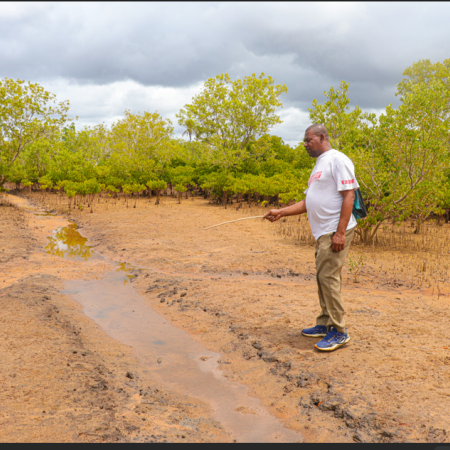
My name is Harith Mohamed, chairman of Vajiki CFA. Here we are in Jimbo restoration called Bazo Vibangani. Previously, we started by planting in the restoration works, which was unsuccessful. However, with the help of the Kenya Marine Fisheries Research Institute (KMFRI) and the support of WWF Kenya through the IKI project, we were able to conduct the hydrological restoration project. In simpler terms, we created trenches to help water flow through the degraded area. Through hydrological restoration, we have seen remarkable results as the water flow has brought in seedlings. Regeneration has begun, and the salinity has reduced. Earlier, it was survival for the fittest since it was based on high temperature and high salinity.
I have always been passionate about climate issues, and I noticed climate change in my community after high school. Every time I went to the ocean to fish while awaiting my university call-up, I observed that the paths we used were filled with sand. Upon investigation, I realized that there was bad land use. The community used to farm up to near the shore, causing erosion and leading to the degradation of the mangrove ecosystem, which resulted in the loss of fish and the mangrove.
We were taught based on traditional knowledge that “where there are mangroves, there are fish”. Other factors that were leading to harm to the environment included poor waste management within the community. I then mobilised the community to start and clean the landing sites and the mangrove forest. Unfortunately, when the tremendous tsunami hit Vanga, in 2004, I saw that we were fortunate since the waves were slowed down by the mangrove forest. This birthed the idea of restoring various sites that have been degraded by human interference with the various partners.
With our limited knowledge and capacity, we sought assistance from the Kenya Forest Service and the Kenya Marine Fisheries Research Institute (KMFRI) due to our limited knowledge and resources. Additionally, we have collaborated with WWF-Kenya, who facilitated this hydrological restoration. My observations show that past efforts that failed in these degraded areas have encountered significant improvements over time.

